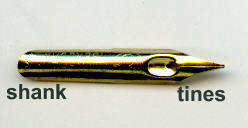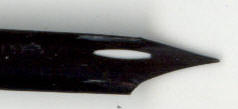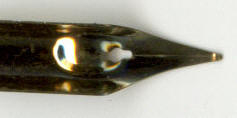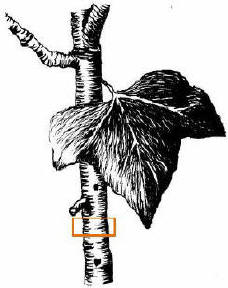|
Main
parts of a Dip Pen Nib.
 A typical
Dip Pen Nib has four main parts:
The Shank, also known as the base or heel - this is the section that goes
into the pen/nib holder. The Tip - which is the point of the nib - this
is divided by a split, the parts either
side of the split are called
Tines: The Vent or breather hole - the split runs from the tip to
the vent. A typical
Dip Pen Nib has four main parts:
The Shank, also known as the base or heel - this is the section that goes
into the pen/nib holder. The Tip - which is the point of the nib - this
is divided by a split, the parts either
side of the split are called
Tines: The Vent or breather hole - the split runs from the tip to
the vent.
The 'Elastic' is the name given to the response of the tines of the nib, this
gives the 'bend-ability', 'springiness' or 'elasticity' of the tines as we use
the nib. Often termed as 'high elastic', 'elastic' and 'low elastic' these terms
refer to hand pressure.
Hand Pressure.
We all use different hand pressure when
writing, this in turn affects the response of the nib tines to our hand. You may
be wondering - is there any guide to our own hand pressure?
Perhaps the easiest way to check hand pressure
is the following:- Using a HB pencil, write on a sheet of A4 plain, light weight
paper (90 gm), fold the paper in half before writing. Place the folded paper on
a table or hard surface and write a couple of sentences, in your normal writing
style. Now check the reverse of the paper to see how much it has been
'impressed' by you and the pencil, also check the folded half to see if an
impression has been made on it.
If the pressure has caused the paper to be
impressed and an impression is showing on the folded half, this would indicate a
fair amount of pressure - often expressed as a 'heavy hand'.
If on checking the reverse side of the written
paper, the paper is slightly impressed but there is little impression showing on
the folded half , this would indicate 'normal hand' pressure.
For a person with a 'light hand' pressure,
there would be very little or no indication of the written paper being
impressed.
Knowing your own hand pressure helps
when choosing the 'elastic' of the nib. The 'manufactures' write up of the nib
usually relates to a 'normal hand' pressure, if you are reading someone else's
write up, it's best to know their hand pressure in order to evaluate it.
As a general guide.
Someone with a 'light hand' will often use
nibs with 'high elastic'. These nib are delicate, responsive and easily damaged,
it takes very little pressure to bend/open the tines. The nib action often feels
'soft' and 'too springy' for a 'normal hand'.
Someone with a 'heavy hand' will often prefer
a stiffer nib with 'low elastic'. These nibs are robust and responsive, it takes
more than normal hand pressure to bend/open the tines. The nib action often
feels 'strong' and 'stiff' to a 'normal hand'.
For the 'normal hand' just the term 'elastic'
if used, 'normal hand' pressure can bend/open the tines of these responsive
nibs. They feel neither 'too soft or strong' and they neither 'too stiff or
springy', but the 'elastic' of the nib often varies slightly with different
makers.
I would suggest you try as many different nibs
as possible, dip pen nibs are not usually expensive. Try for at least three
different types - that allow you to comfortably express your lines.
Different tips.
The 'tip' of dip pen nibs for drawing tend to
fall into two main categories - ones that have a 'needle point' (tip) and those
with a more blunt point and usually have a rounded/ball nib tip.
This shows the underside of the
Gillott 303 nib, a 'needle point tip'.

This shows the underside of the
Brause
Cito Fein, a 'rounded tip'.

If you are looking to produce fine 'hair-like'
lines, then a sharp 'needle point' tip is the best choice. Nibs with a 'rounded'
tip will give fine lines but because of the larger area of the rounded tip,
which supplies more ink to the paper, they will not give 'hair-like' lines.
The
Gillott drawing nibs and their equivalent,
are often the preferred nib for 'pen and ink' work. With these expressive nibs
you can achieve from fine, hair-like lines to wide 'chunky' lines. For anyone
new to using these 'needle point' nibs, the first problem is the 'scratchy' feel
when in use and for that reason alone may people give up on them. This is a
shame, because these nibs are well worth persevering with, especially if you
want those 'fine ink lines'!
Like any new instrument you use, it can be
strange and different at first. One way that may help you to ignore 'the
scratchiness', is to think about what you are doing with the ink and not the nib
you are using. That may sound a strange thing to say - but the more you think
about the sound and feel of the nib, the less you think about the marks you are
trying to make! The more you use the nib, the more it becomes a friend.
An Example of line thickness.

I would consider myself to have a 'normal
hand' - this close-up picture shows the 'elasticity' of the
Joseph Gillott 170, from
fine to wide lines.

To give an idea of the scale, it is a very
small part of this quick pen and ink sketch on the right, which measure approx.
3" x 2"

A few lines with the
Joseph Gillott 303, showing the variable line width
possibilities.
These Joseph Gillott nibs are also used for
Copperplate and
other writing styles and fit into the Joseph Gillott Drawing Pen Holder.
Dip pen nibs
Nib holders
Ink selection
Dip pen nib and holder sets
Vintage Dip pen nibs
Copyright Jacqui Blackman 2005 
|